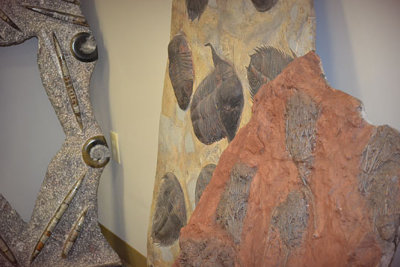
During the Devonian period, Palaeozoic era, approximately 380 millions years ago, the Moroccan Sahara was a floor of a vast prehistoric ocean, the first Mediterranean sea,proto-tethys. Because of different natural factors, fish, plants and other old sea animals and organisms were fossilized after the withdrawal of the sea.
Lack of oxygen, tectonic movement and high temperature are the main natural factors. The south-east Moroccan Sahara is now a rich source of a very old and different fossils.
Geologically speaking, there are many land mines and quarries where fossils are embedded within huge rocks. each quarry has its specific features in terms of age raw material and colors of fossils. Trilobites,ammonites,goniatites and orthoceras are the widespread in the Sahara. On the one hand, some fossils are embedded within huge and vast marble quarries either in black or brown color. For example, black marble is very rich in orthoceras or squids sediment, while the brown marble is very rich in both orthoceras and ammonites. On the other hand, some other fossils are located in mountains within limestone rocks such as trilobites.
More importantly, the Sahara is very famous with its unique fossilized marble. There are two kinds of marble: black predominates in the atlas mountains on the way to Ouarzazate. Brown marble is found 15 km. from Erfoud where the quary is quite rich in ammonites and orthoceras.
Some Definitions
- AMMONITES: cephalopods that lived during the Jurassic and Cretaceous periods of earth history, an interval of about 140 million years. The Jurassic period began about 205 millions years and the Cretaceous ended about 150. We know about them as they are commonly found as fossils, formed when the remains or traces of the animals became buried in the sediment which is later solidified into rocks. They became extinct at the end of Cretaceous period. We have also goniatities, which are from the same family of ammonites but they differ in terms of suture and age. Goniatites lived in the Devonian sea with curbed sutures unlike ammonites, which lived in the Jurassic but with simple sutures.
- ORTHOCERAS: sedimentary cephalopods with simple and long sutures. They lived in the Devonian period and came from squid sediments. They are multi-dimensional.
- TRILOBITES: arthropods sediments, which are the most important of early sea animals. Our knowledge has been gained from the study of their fossils, usually impressions and traces left of their shells after burial in sediment which subsequently hardened into rocks. They abruptly lived in the early part of the Cambrian and came to dominate the Ordovician and the beginning of the Devonian sea. They came from old sea animals like crustaceans, spiders and insects. Generally, their formation was based on limestone raw material. Theywere specialists who worked with skilful tools. According to geologists, there are more than ten thousand species of trilobites. Each one has its specific term in geology. In Morocco, there are more than two hundreds species, the most famous Moroccan trilobites are phacops , methacanthina, ceratarges….etc.



